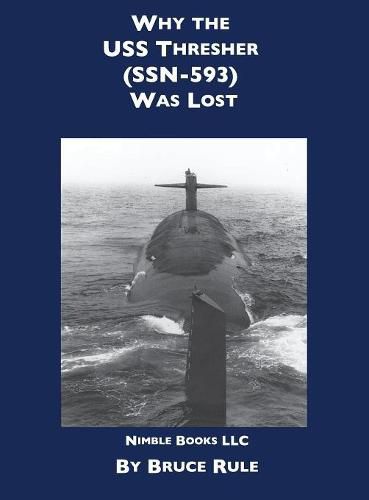Readings Newsletter
Become a Readings Member to make your shopping experience even easier.
Sign in or sign up for free!
You’re not far away from qualifying for FREE standard shipping within Australia
You’ve qualified for FREE standard shipping within Australia
The cart is loading…






The US nuclear submarine THRESHER (SSN-593) was lost because standard compensation procedures to adjust for hull compression during the deep-dive on 10 April 1963 were not followed. Consequently, THRESHER was heavy (negatively buoyant) at test-depth (1300 feet) and unable to deballast because adiabatic cooling froze moisture in the air-lines to the ballast tanks, blocking those lines.
Operation of the Reactor (Main) Coolant Pumps in FAST (2-pole mode) may have contributed to a reactor scram (shut-down) and loss of propulsion at 0909.0R (local time). THRESHER sank at an average rate of 120ft/min from test-depth (1300-feet) at 0909.0R to collapse at 09:18:24R at a depth of 2400-feet (1070 psi) in 1/20th of a second, too fast to be cognitively recognized by those aboard who - although they knew collapse was imminent - never knew it was occurring.
The Navy Court of Inquiry (COl) dismissed the results of their own test which established conclusively that flooding at test-depth - the COI’s assessed cause of the disaster - would have been a catastrophic
event and would not have been reported by THRESHER to her escort ship, the USS SKYLARK (ASR 20), at 0913R as experiencing minor difficulties. Multiple lines of evidence - discussed in detail by Chapter
1 of this assessment - confirm there was no flooding prior to collapse of the pressure-hull at great depth.
$9.00 standard shipping within Australia
FREE standard shipping within Australia for orders over $100.00
Express & International shipping calculated at checkout
The US nuclear submarine THRESHER (SSN-593) was lost because standard compensation procedures to adjust for hull compression during the deep-dive on 10 April 1963 were not followed. Consequently, THRESHER was heavy (negatively buoyant) at test-depth (1300 feet) and unable to deballast because adiabatic cooling froze moisture in the air-lines to the ballast tanks, blocking those lines.
Operation of the Reactor (Main) Coolant Pumps in FAST (2-pole mode) may have contributed to a reactor scram (shut-down) and loss of propulsion at 0909.0R (local time). THRESHER sank at an average rate of 120ft/min from test-depth (1300-feet) at 0909.0R to collapse at 09:18:24R at a depth of 2400-feet (1070 psi) in 1/20th of a second, too fast to be cognitively recognized by those aboard who - although they knew collapse was imminent - never knew it was occurring.
The Navy Court of Inquiry (COl) dismissed the results of their own test which established conclusively that flooding at test-depth - the COI’s assessed cause of the disaster - would have been a catastrophic
event and would not have been reported by THRESHER to her escort ship, the USS SKYLARK (ASR 20), at 0913R as experiencing minor difficulties. Multiple lines of evidence - discussed in detail by Chapter
1 of this assessment - confirm there was no flooding prior to collapse of the pressure-hull at great depth.